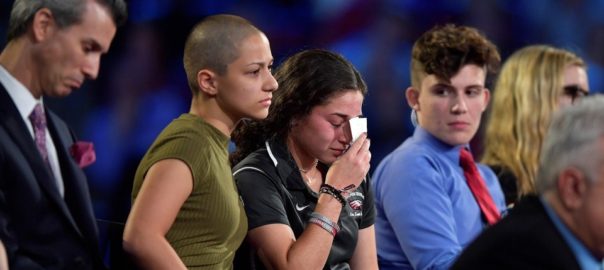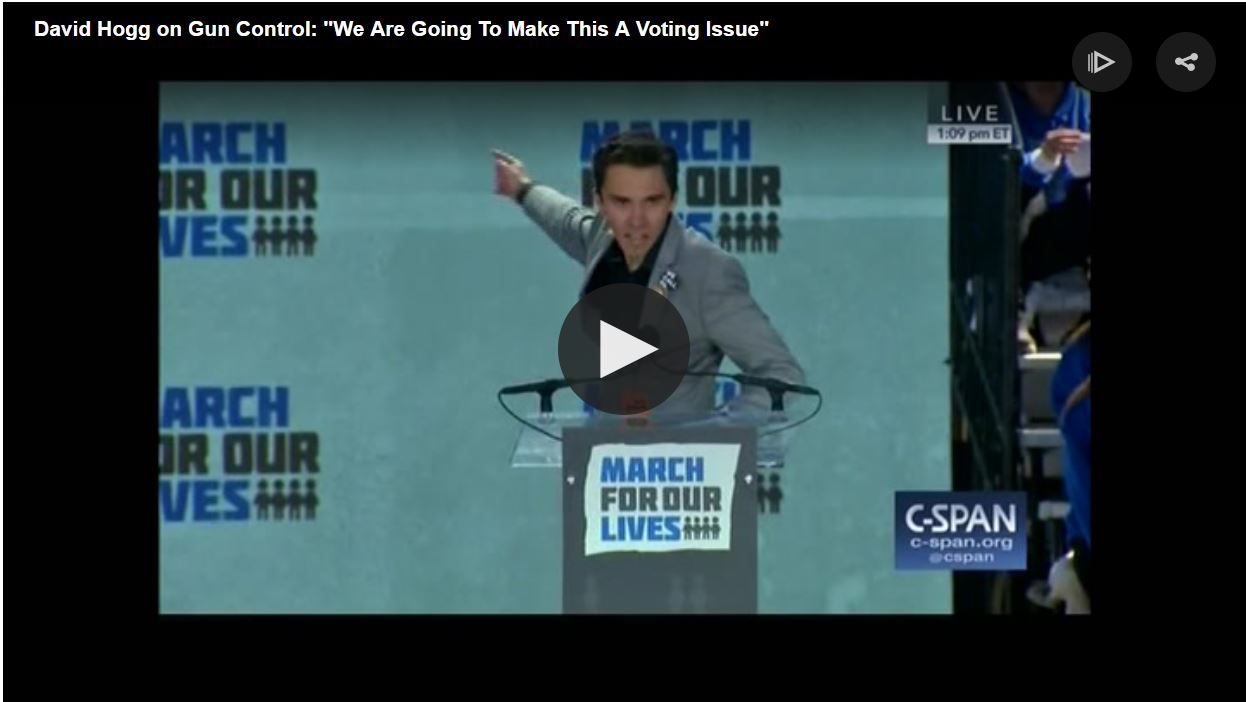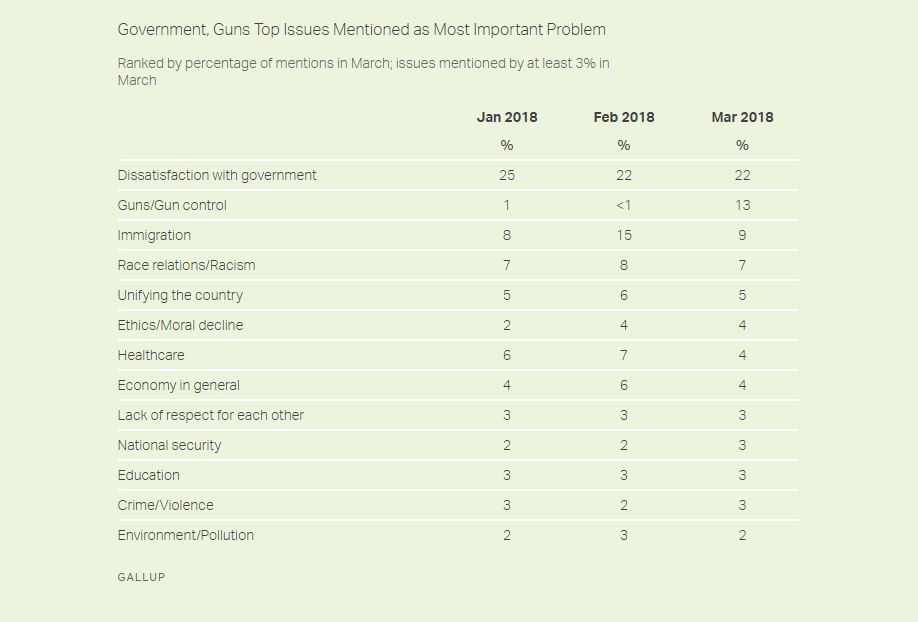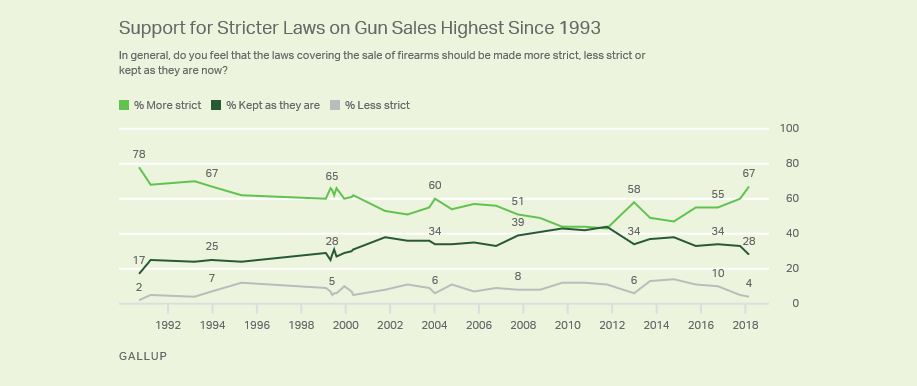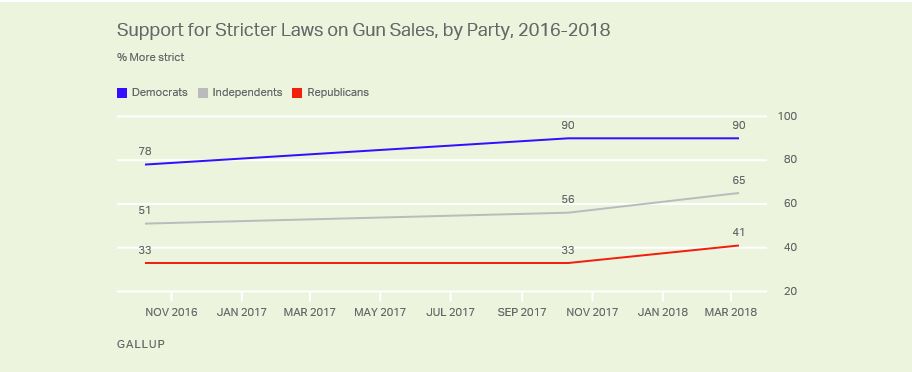By Kent R. Kroeger (Source: NuQum.com, March 26, 2018)
{Send comments to: kkroeger@nuqum.com}
Parkland student David Hogg’s impassioned plea at the March for Our Lives rally in Washington, D.C. over the weekend to hold lawmakers accountable at the ballot box if they don’t pass gun control legislation soon was an exercise in earnest cluelessness.
Hogg’s sincerity is not the issue. That the Democratic Party and its network of government-empowering interest groups would use children to advance their political agendas, though troubling, is not the issue.
The problem with the March for Our Lives movement and pro-gun control Americans in general is that they are fighting a battle that is rigged against them. Earnestness, persistence and hard work will not overcome that problem. Voting Republicans out of office won’t even help.
First things first, I must disclose my own biases on this issue. I fully support banning “assault weapons” and their deadly enhancements, such as high capacity magazines and bump stocks. Unlike the 1994 assault weapons ban, which left many loopholes in its definition of an “assault weapon,” I would aggressively broaden the definition (For an excellent summary of the deep flaws in the 1994 Assault Weapons Ban, I recommend Brad Blumer’s article in the Washington Post from December 17, 2012).
“Experts who have studied the (1994) law tend to agree that it was rife with loopholes and generally ineffective at curbing gun violence,” reported Blumer in his 2012 Washington Post article.
And why was the law ineffective?
“For starters, only 18 firearm models were explicitly banned. But it was easy for gun manufacturers to modify weapons slightly so that they didn’t fall under the ban. One example: the Colt AR-15 that James Holmes used to shoot up a movie theater in Aurora, Colo., last summer would have been outlawed. Yet it would have been perfectly legal for Holmes to have purchased a very similar Colt Match Target rifle, which didn’t fall under the ban,” wrote Blumer.
I want to see substantive gun control legislation passed in this country as soon as possible. Unfortunately, the marches I watched on Saturday didn’t address the barriers to gun control and may have, in fact, setback any chance of such legislation passing anytime soon.
Three factors work against seeing any meaningful gun control legislation passed by this Congress, or a Democrat-controlled Congress after the 2018 midterms.
The Constitution stands in the way of gun control legislation
The first factor is the constitution itself. Often we hear a pro-control argument that goes something like this: “There are more legal and administrative restrictions in place to restrict our ability to get a driver’s license than there are to buy a gun.”
The problem with that argument is that we don’t have a constitutional right to drive a car. If we did, the barriers to getting a driver’s license would be very different. An absurd comparison only because there were no cars when the Founding Fathers wrote the constitution.
But what about the right to vote? That is also a constitutional right that is continuously threatened by Republican efforts to erect more and more barriers to the voting booth.
While true in the short-term, the historical arc with respect to voting rights in this country actually supports the notion that gun rights are going to be protected by future courts as well. With few exceptions, the voting franchise has been consistently expanded and barriers to voting significantly reduced since this country’s founding.
When Republicans tried to pass a voter ID law in North Carolina in 2013, the Supreme Court quickly knocked it down by allowing lower court rulings against it to stand.
The Fourth Circuit court found in 2016 that the 2013 package of voting reforms in North Carolina, including the establishment of a strict voter-ID requirement and restrictions on early voting and same-day registration, “were enacted with racially discriminatory intent.”
When something is a constitutional right, the courts take a circumspect view of attempts to restrict that something.
If the Constitution included a positive right to basic health care, which has been erroneously suggested as FDR’s intent in his “Second Bill of Rights” speech in 1941, we would have had universal health care in this country already.
But we don’t.
Gun control advocates face a similar problem.
James Madison, our fourth president and Father of the U.S. Constitution, laid out in Federalist Paper No. 46 the importance of the people possessing the right to form well regulated state militias:
“Let a regular army, fully equal to the resources of the country, be formed; and let it be entirely at the devotion of the federal government; still it would not be going too far to say, that the State governments, with the people on their side, would be able to repel the danger.”
Our Founding Fathers had good reason not to trust a federal government. History was rich with evidence showing strong central governments monopolizing the tools of violence to control the people.
If state militias are essential to repelling a federal army, in Madison’s view, and in sharp contrast to the views of many European legal scholars at the time, the American republic cannot be afraid to “trust the people with arms.”
Subsequent to Madison’s writings, early U.S. court rulings adopted a restricted (well regulated militia) view of the Second Amendment. In United States v. Miller (1939) the majority opinion for the U.S. Supreme Court wrote: “The Court cannot take judicial notice that a shotgun having a barrel less than 18 inches long has today any reasonable relation to the preservation or efficiency of a well regulated militia, and therefore cannot say that the Second Amendment guarantees to the citizen the right to keep and bear such a weapon.”
Hardly a stance the National Rifle Association (NRA) would endorse today. And, since 1939, U.S. courts have taken increasingly more negative views of attempts to restrict gun rights, in part, due to the NRA’s expansive and sophisticated lobbying efforts.
There is no question the NRA has been a powerful force for gun rights, though its power is exaggerated through its association with the inherent potency of a constitutional amendment.
Take away the Second Amendment, we wouldn’t be talking about banning assault weapons in the U.S. right now. From their first inception they would have been banned.
Partisanship hurts the prospects of gun control legislation
The second factor is the role of partisanship in national policymaking.
Once partisanship has infected an issue, it is all but impossible to pass substantive and enduring legislation.
Partisanship has given us a graveyard of stunted and unfulfilled legislative dreams. National health care? Partisanship gave us the weak alternative called Obamacare. It may well die before another Democratic president and Congress can get elected.
A sustained national commitment to a complete conversion to renewable energy to combat global warming? Partisanship has limited government action to a series of executive orders and bureaucratic rulemaking, all potentially reversed under an opposing party’s administration.
Is there an example of a current national policy driven by a bipartisan consensus?
Yes — the vast majority of federal spending: Social Security, Medicare/Medicaid, debt servicing and national defense.
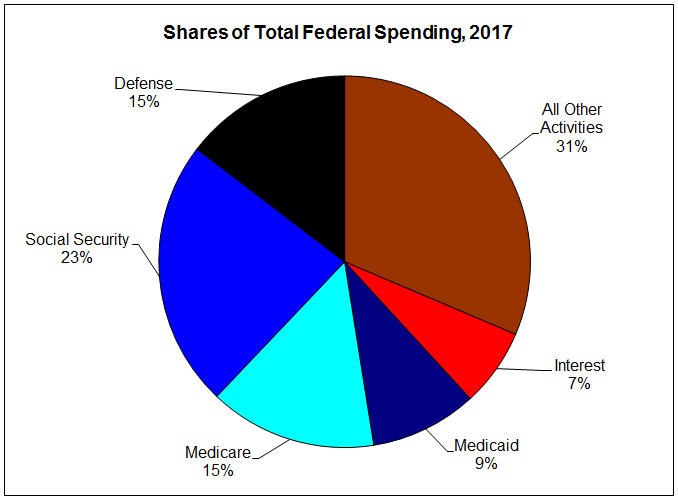
Attempts to cut Social Security or Medicare/Medicaid spending is token at best, typically led by a small faction of libertarian deficit-hawks in the Republican Party (e.g., Senators Rand Paul and Mike Lee).
As for defense spending, the overwhelming majority of congressional Democrats and Republicans can’t fall over themselves fast enough to put money behind their shared prosaicism that they want to “support our troops.” The flat defense spending under Obama was the result of his administration overseeing the reduction in combat operations initiated under George W. Bush. And the increases just passed by the current Congress and signed by Trump significantly reverse those lean Obama budgets.
When bipartisanship prevails, substantive legislation happens. When partisanship takes over, substance is replaced by platitudes and posturing.
That is a fair summary of the rhetoric at the March for Our Lives.
Parkland students, like Hogg, lecturing their “old ass parents” for not knowing how to “use a f-king democracy” is not only laughably stupid and ahistorical, but does more to help ignite the backlash against passing gun control legislation.
Had the Democratic Party and associated interest groups not co-opted the Parkland students, there may have been a real chance to see a broad assault weapons ban in this country. Once CNN, Ted Lieu and Debbie Wasserman-Schultz got their paws on the Parkland students, however, the odds of such legislation dropped dramatically.
Enabling the Parkland students to publicly humiliate Florida Senator Marco Rubio during the CNN town hall on gun control or during the March for Our Lives rally didn’t help either.
Rubio is the exact type of Republican the gun control lobby needs to be working with, not against.
At this point, assuming the Democrats control both the White House and Congress after 2020 presidential election, the best-case scenario is passing an assault weapons ban as riddled with loopholes as the 1994 law.
Only a bipartisan effort can hope to counterbalance the NRA’s influence on the relevant congressional committees.
The importance of gun control to the American public is volatile
The third factor stopping gun control legislation is its long-term volatility in importance relative to other problems facing our nation.
In its most recent poll on the most important problems facing the U.S., the Gallup Organization reports a surge in their importance of gun control.
“The U.S. Gallup’s March update finds 13 percent of Americans mentioning guns, up from less than 1 percent in early February, before the (Parkland) shooting occurred,” according to Gallup analyst Jeffrey Jones. “The percentage mentioning guns in response to this open-ended question is the highest Gallup has recorded since it first began compiling mentions of gun-related issues in 1994. The previous high was 10 percent after the Columbine school shooting in Littleton, Colorado.”
Not surprisingly, this current rise in the importance of gun control is driven by the Parkland shooting incident. Opinion surveys, particularly when asked about national issues most Americans only experience through the media, are mostly reflections of what people directly or indirectly read, hear and see in the media. Opinion surveys are prone to the ephemeral effects of event-driven phenomena.
But policymaking is typically a long-term project. The volatility in the importance of gun control to average Americans will not work in gun control advocates’ favor. As the table below shows, the importance of gun control spiked with the Las Vegas shooting in October 2017 but quickly eroded by December. The importance of gun control will fall after Parkland too. Perhaps not as fast or as far as previous shootings because of the news media’s higher level of attention to the issue, but it will fall.
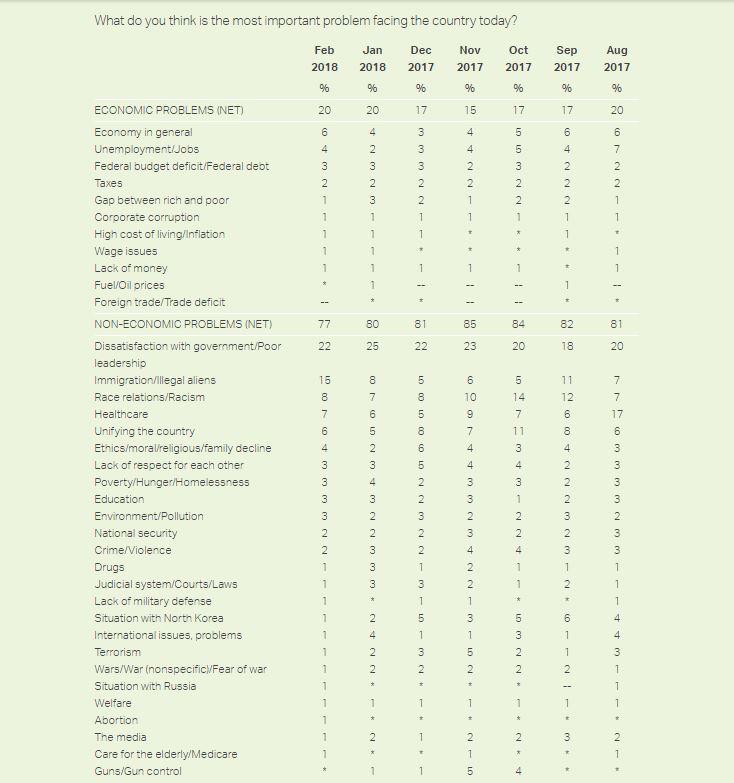
Assigning too much weight to poll results at this point only sets up gun control advocates for the inevitable disappointment when the media spotlight turns to the next cable-news-driven event (Stormy Daniels Round 2? The next series of Mueller indictments? The next stock market collapse? A strategic strike on North Korea or Iran?). It is just a matter of time and if there is no action in Congress soon on gun control, the chances of passing an assault weapons ban diminish rapidly.
The Democrats must strike while the iron is hot.
“If [McConnell and Ryan] were to simply let the (gun control) bills comes to the floor, they would pass,” New York Senator Chuck Schumer said at the March for Our Lives rally in Washington, D.C. “The NRA represents a small minority, but it has a stranglehold on Leader McConnell and Speaker Ryan.”
But McConnell has already tabled gun control on the Senate’s 2018 schedule in favor of banking reform. Anything gun control legislation that does make it to the floor before the midterms will be limited to enhancing background checks, raising age minimums for gun purchases, and limiting the sale of bump stocks and high capacity magazines. Those are not insignificant policy changes, but they are not likely to change the levels of gun violence in this country.
With the deck stacked against them, what are gun control advocates supposed to do?
Of course, giving up on passing gun control legislation is not an option.
But anyone advocating changing the Second Amendment is spitting into the wind.
Instead, gun control advocates must focus on what they can control: the media and themselves.
Hopefully, it is not controversial anymore to say that the major news media outlets (Fox News and The Wall Street Journal notwithstanding) are in the tank for the establishment Democrats’ political agenda.
That fact is a double-edged sword for gun control advocates. On the one hand, anything that can keep gun violence high on the public agenda works to their advantage. But by associating gun control with a partisan agenda works to their disadvantage.
At a minimum, adults need to assert control of the message coming out of the gun control movement. The maudlin, over-heated theatrics coming from the Parkland students will backfire over time if left unfiltered.
If there is one iron-law in political communication it is that Americans don’t like to see their political leaders excessively emotional. It is tolerated in brief, well-defined moments: Reagan hugging the family members of the space shuttle Challenger victims. Obama shedding a tear for the Sandy Hook students.
Gun violence victims and their families should express their profound emotions. But for political leaders, crying, swearing and yelling are generally not effective political communication styles.
Effective political leaders are not victims. They are compassionate but even-tempered, and when they do show strong emotions, they must appear in control of those emotions.
But the sonics and optics at these mega-marches, including the Women’s march in January 2017, are not designed to attract fence-sitters and independents to a cause. These marches are meant to rally troops (hence, why they are called ‘rallies’!), but they are piss-poor at expanding a political base.
The Vietnam War marches ushered in two Richard Nixon election victories. The Nuclear Disarmament Marches in the 1980s preceded Ronald Reagan’s 1984 electoral victory, the largest election landslide since FDR.
The point is, marches don’t necessarily presage significant political victories in the marchers’ favor.
Two-thirds of Americans now support stronger gun control measures. The rise in support is almost exclusively among Republicans and Independents, not Democrats (see charts below):
It is support among independents and Republicans that will determine the final outcome of the current momentum to pass gun control legislation. Calling anyone over 18-years-old part of the problem, which is what more than one Parkland teen expressed at Saturday’s march, is a recipe for choking off the momentum gained since the Parkland shooting tragedy.
Chuck Schumer telling marchers that the students like those at Parkland “are our leaders” says more about the Democratic Party’s leadership vacuum than anything else.
Gun control advocates therefore should take that as a sign that letting their movement align with the Democratic Party is a grave mistake.
There are Republicans ready to work with the Democrats on meaningful gun control legislation. Don’t alienate them with immature spokespeople like David Hogg.
K.R.K.
{Send comments to: kkroeger@nuqum.com}
About the author: Kent Kroeger is a writer and statistical consultant with over 30 -years experience measuring and analyzing public opinion for public and private sector clients. He also spent ten years working for the U.S. Department of Defense’s Office of the Under Secretary of Defense for Personnel and Readiness and the Defense Intelligence Agency. He holds a B.S. degree in Journalism/Political Science from The University of Iowa, and an M.A. in Quantitative Methods from Columbia University (New York, NY). He lives in Ewing, New Jersey with his wife and son.
